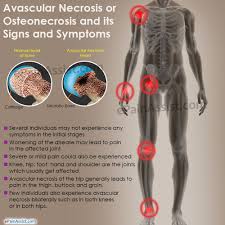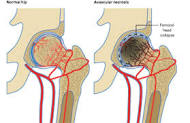
Diagnosed with Cancer? Your two greatest challenges are understanding cancer and understanding possible side effects from chemo and radiation. Knowledge is Power!
Learn about conventional, complementary, and integrative therapies.
Dealing with treatment side effects? Learn about evidence-based therapies to alleviate your symptoms.
Click the orange button to the right to learn more.
- You are here:
- Home »
- Blog »
- side effects ID and prevention »
- Healing Avascular Necrosis in My Shoulders
Healing Avascular Necrosis in My Shoulders

“Stage at initial visit, occurrence of pain, and continuation of peak doses of corticosteroids predicted progression of disease in asymptomatic shoulders, whereas in the symptomatic shoulders, extent and location of the lesion were the main risk factors for progression.”
Avascular Necrosis (AVN) was the problem that side lined Bo Jackson’s football career. Just thought I mention that…
I was diagnosed with multiple myeloma in early 1994. I underwent multiple courses of a chemotherapy-cocktail which included a high dose corticosteroid called dexamethasone. I began experiencing shoulder pain in both shoulders in about 2015- about 20 years after my high-dose steroids.
To be clear, the article linked below is talking about AVN of the hip joint and I am talking about AVN of the shoulder joint. Same problem, different body part.
I do not want to undergo shoulder reconstruction for the Avascular Necrosis in my shoulders. I think the potential risks outweigh the possible benefits. My therapy plan then, is to reduce any/all pain to a manageable level and then make sure that the bone doesn’t “collapse.”
I’m posting the study below that cites “novel stem cell therapies” as a possible therapy for AVN because I think this therapy will someday be advanced enough to help me.
Do I think I will completely heal my shoulder osteonecrosis? No. But I believe that through:
- Moderate exercise
- Nutritional supplementation
- Acupuncture
- Sauna
- Extracorporeal shock wave therapy (ESWT) and
- Intra-articular platelet-rich plasma (PRP) injection
As of now, October 2021, I have managed my shoulder necrosis pretty well with exercise, supplementation, acupuncture, and frequent saunas.
Supplementation such as Curcumin and Wobenzyme along with both sauna 2-3 times a week and acupuncture once a month have minimized any shoulder pain I experience.
As of 2/7/2022, I have undergone regular acupuncture for the preceding several months.
Today, 2/7/2022, I had my first Extracorporeal shock wave therapy (ESWT) session. I can’t predict long-term benefit or not at this early stage.
But rest assured I will keep an eye on the progress of therapies like novel stem cells therapy discussed in the article below. I figure I am already ahead of the game. By this I mean that I have already experienced the harvesting of my own bone marrow cells. A bone marrow biopsy (BMB) is a standard diagnostic tool for people with multiple myeloma.
Steroid-induced AVN is a fairly common problem is you survive cancer long enough. To learn more about evidence-based, non-conventional AVN therapies, scroll down the page, post a comment or question and I will reply to you ASAP.
Learn about healing chemotherapy-induced aging- click now
Thanks and hang in there,
David Emerson
- MM Survivor
- MM Cancer Coach
- Director PeopleBeatingCancer
Recommended Reading:
PeopleBeatingCancer- Side Effects Program
Multiple Myeloma Side Effects- CIPN, RILP
The Natural Progression of Shoulder Osteonecrosis Related to Corticosteroid Treatment
“Purpose- We retrospectively evaluated 125 patients (215 shoulders) with humeral head ON diagnosed by MRI to determine the delay between corticosteroid treatment and the different stages and factors influencing the progression of the disease.
Methods- Seventy-four of the shoulders had asymptomatic Stage I ON, 58 had asymptomatic Stage II ON, 46 had symptomatic Stage I ON, and 37 had symptomatic Stage II ON. The minimum followup was 10 years (average, 14 years; range, 10–20 years). The delay between the beginning of the corticosteroid treatment and the diagnosis of ON of the humeral head averaged 15 months (range, 6–24 months).
Results- We observed partial or total regression on MRI only in patients with asymptomatic Stage I ON. At last followup, pain had developed in 98 (74%) and collapse had occurred in 71 (54%) of the 132 previously asymptomatic shoulders. Of the 83 symptomatic shoulders, 68 (82%) had collapsed at the final followup. The time between diagnosis and collapse averaged 10 years for patients with symptomatic Stage I ON and 3 years for patients with symptomatic Stage II ON.
Conclusions- Stage at initial visit, occurrence of pain, and continuation of peak doses of corticosteroids predicted progression of disease in asymptomatic shoulders, whereas in the symptomatic shoulders, extent and location of the lesion were the main risk factors for progression…”
Stem Cells Used to Treat Avascular Necrosis of the Femoral Head
“Collapsed femoral heads caused by osteonecrosis—otherwise known as avascular necrosis— unfortunately represent the root cause for approximately 10% of all hip replacements nationwide…
Occurring in more than 20,000 Americans each year, osteonecrosis of the femoral head is commonly diagnosed in patients in their 30s and 40s. The disease is caused by injury of the blood supply to the head of the femur, which is the ball portion of the hip’s ball and socket joint…
If unaddressed, this disease may ultimately lead to the collapse of the femoral head, requiring the patient to undergo a hip replacement. For patients in this age group, a total hip replacement is not ideal as it likely will wear out and the patient will require more surgery…
According to Wiznia, this treatment reduces the risk of the head of the femur from collapsing, and the stem cell therapy has shown promising results. Soon after the procedure, many patients with avascular necrosis experience rejuvenated blood supply to the area and the bone is repopulated with new cells. This can additionally alleviate the short-term need for a hip replacement.
“This novel stem cell therapy has demonstrated improved pain and function, and the stem cells decrease the risk of the femoral head from collapsing,” Wiznia said. “This translates into fewer young patients requiring hip replacements, and subsequent surgeries in their later years…”
Comparisons of Ultrasound-Guided Platelet-Rich Plasma Intra-Articular Injection and Extracorporeal Shock Wave Therapy in Treating ARCO I–III Symptomatic Non-Traumatic Femoral Head Necrosis: A Randomized Controlled Clinical Trial
“Background and Objective: Osteonecrosis of the femoral head (ONFH) is a devastating disease, and there is some evidence that extracorporeal shock wave therapy (ESWT) and intra-articular platelet-rich plasma (PRP) injection might alleviate pain and improve joint function in individuals with ONFH. The objective of this study was to compare the effectiveness and safety of PRP and ESWT in symptomatic ONFH patients.
Results: There were significant differences between groups in terms of changes over time for VAS, PPTs, WOMAC, and HHS since 3-month and maintained up to 12-month (P< 0.05, except for PPTs at 12-month). The simple main effects showed that the patients in PRP group had greater improvements in VAS (mean difference = − 0.82, 95% CI [− 1.39, − 0.25], P=0.005), WOMAC (mean difference = − 4.19, 95% CI [− 7.00, − 1.37], P=0.004), and HHS (mean difference = 5.28, 95% CI [1.94, 8.62], P=0.002). No related adverse events were reported.
Conclusion: This study supported the effectiveness and safety of both the PRP injection and ESWT in treating ONFH patients. For symptomatic patients with ONFH, intra-articular PRP injection appeared superior to ESWT in pain relief and functional improvement.


